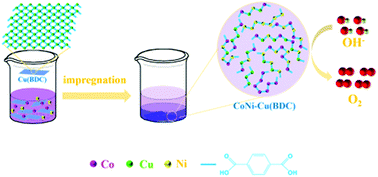当前位置:
X-MOL 学术
›
New J. Chem.
›
论文详情
Our official English website, www.x-mol.net, welcomes your feedback! (Note: you will need to create a separate account there.)
MOF-derived CuCoNi trimetallic hybrids as efficient oxygen evolution reaction electrocatalysts
New Journal of Chemistry ( IF 3.3 ) Pub Date : 2020/01/14 , DOI: 10.1039/c9nj05562b Junchao Ma 1, 2, 3, 4, 5 , Boyan Lu 1, 2, 3, 4, 5 , Sha Wang 1, 2, 3, 4, 5 , Wenxiu He 1, 2, 3, 4, 5 , Xiaojue Bai 1, 2, 3, 4, 5 , Tieqiang Wang 1, 2, 3, 4, 5 , Xuemin Zhang 1, 2, 3, 4, 5 , Yunong Li 1, 2, 3, 4, 5 , Liying Zhang 1, 2, 3, 4, 5 , Junyi Chen 5, 6, 7, 8, 9 , Fanbao Meng 1, 2, 3, 4, 5 , Yu Fu 1, 2, 3, 4, 5
New Journal of Chemistry ( IF 3.3 ) Pub Date : 2020/01/14 , DOI: 10.1039/c9nj05562b Junchao Ma 1, 2, 3, 4, 5 , Boyan Lu 1, 2, 3, 4, 5 , Sha Wang 1, 2, 3, 4, 5 , Wenxiu He 1, 2, 3, 4, 5 , Xiaojue Bai 1, 2, 3, 4, 5 , Tieqiang Wang 1, 2, 3, 4, 5 , Xuemin Zhang 1, 2, 3, 4, 5 , Yunong Li 1, 2, 3, 4, 5 , Liying Zhang 1, 2, 3, 4, 5 , Junyi Chen 5, 6, 7, 8, 9 , Fanbao Meng 1, 2, 3, 4, 5 , Yu Fu 1, 2, 3, 4, 5
Affiliation

|
Metal–organic frameworks (MOFs) as templates can easily form homogeneous multimetallic materials via metal ion exchange, and they have been widely used as electrocatalysts in the oxygen evolution reaction (OER) due to the synergistic effect of the metal ions. Herein, by selecting Cu(BDC) as a template, a simple one-step impregnation method was used to prepare CuCoNi trimetallic electrocatalysts, which exhibited excellent catalytic performance for the OER with a low overpotential of 327 mV at a 10 mA cm−2 current density and a small Tafel slope of 75.7 mV dec−1. The outstanding OER activity may be attributed to the transformed 2D lamellar morphology, amorphous structure and the synergistic effect of the metal species.
中文翻译:

MOF衍生的CuCoNi三金属杂化物作为高效的析氧反应电催化剂
作为模板的金属有机框架(MOF)可以通过金属离子交换轻松形成均质的多金属材料,由于金属离子的协同作用,它们已广泛用作氧释放反应(OER)中的电催化剂。在此,以Cu(BDC)为模板,采用简单的一步浸渍法制备了CuCoNi三金属电催化剂,该催化剂对OER具有良好的催化性能,在10 mA cm -2的电流下低过电势为327 mV。密度和75.7 mV dec -1的小Tafel斜率。杰出的OER活性可能归因于2D层状晶形的转变,非晶态结构和金属物种的协同效应。
更新日期:2020-02-13
中文翻译:

MOF衍生的CuCoNi三金属杂化物作为高效的析氧反应电催化剂
作为模板的金属有机框架(MOF)可以通过金属离子交换轻松形成均质的多金属材料,由于金属离子的协同作用,它们已广泛用作氧释放反应(OER)中的电催化剂。在此,以Cu(BDC)为模板,采用简单的一步浸渍法制备了CuCoNi三金属电催化剂,该催化剂对OER具有良好的催化性能,在10 mA cm -2的电流下低过电势为327 mV。密度和75.7 mV dec -1的小Tafel斜率。杰出的OER活性可能归因于2D层状晶形的转变,非晶态结构和金属物种的协同效应。

























 京公网安备 11010802027423号
京公网安备 11010802027423号